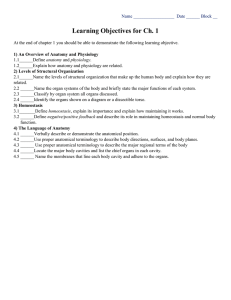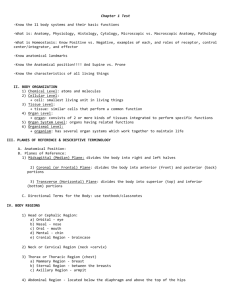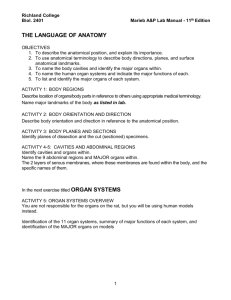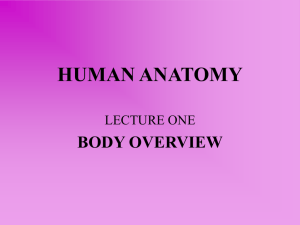A. Explain the positive feedback system and give an... B. Explain the negative feedback system and give an... Chapter 1: Introduction to Human Anatomy and Physiology
advertisement
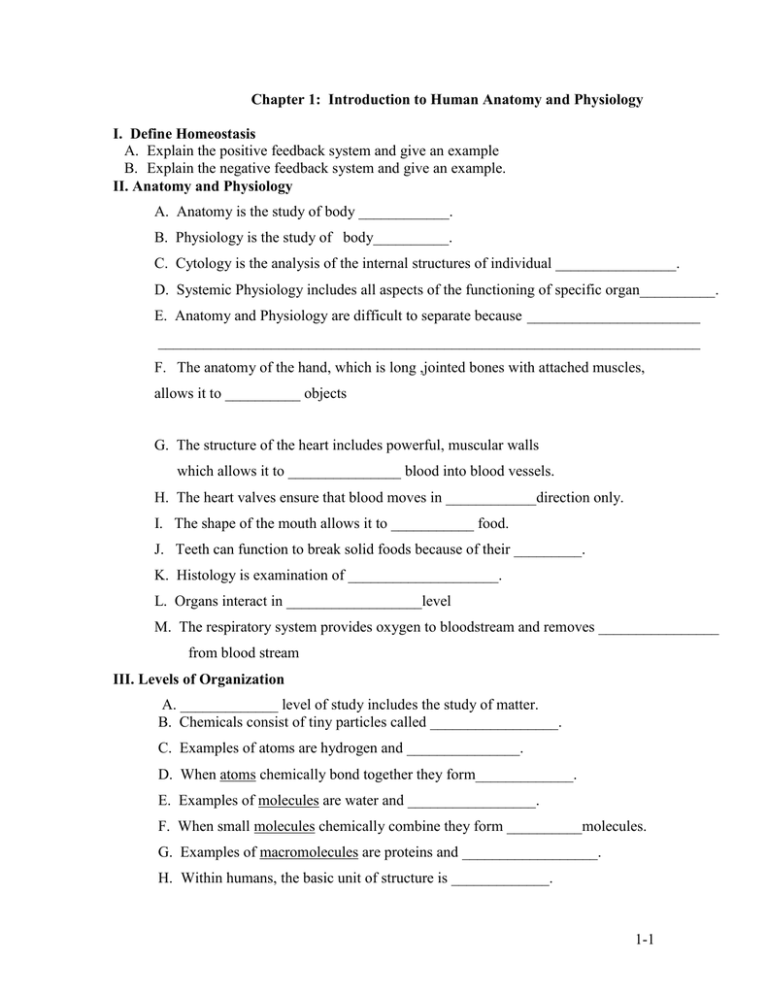
Chapter 1: Introduction to Human Anatomy and Physiology I. Define Homeostasis A. Explain the positive feedback system and give an example B. Explain the negative feedback system and give an example. II. Anatomy and Physiology A. Anatomy is the study of body ____________. B. Physiology is the study of body__________. C. Cytology is the analysis of the internal structures of individual ________________. D. Systemic Physiology includes all aspects of the functioning of specific organ__________. E. Anatomy and Physiology are difficult to separate because _______________________ ________________________________________________________________________ F. The anatomy of the hand, which is long ,jointed bones with attached muscles, allows it to __________ objects G. The structure of the heart includes powerful, muscular walls which allows it to _______________ blood into blood vessels. H. The heart valves ensure that blood moves in ____________direction only. I. The shape of the mouth allows it to ___________ food. J. Teeth can function to break solid foods because of their _________. K. Histology is examination of ____________________. L. Organs interact in __________________level M. The respiratory system provides oxygen to bloodstream and removes ________________ from blood stream III. Levels of Organization A. _____________ level of study includes the study of matter. B. Chemicals consist of tiny particles called _________________. C. Examples of atoms are hydrogen and _______________. D. When atoms chemically bond together they form_____________. E. Examples of molecules are water and _________________. F. When small molecules chemically combine they form __________molecules. G. Examples of macromolecules are proteins and __________________. H. Within humans, the basic unit of structure is _____________. 1-1 I. Cells are made of small structures called_____________________. J. Organelles are made of ___________molecules. K. Examples of organelles are mitochondria, golgi apparatus and ___________. L. Examples of cells are muscle cells and _____________cells M. Tissues are formed from similar ___________. N. Examples of tissues are simple squamous epithelium and ______________________. O. Organs are formed from ____________________. P. Examples of organs are skin, femur, heart and _____________. Q. Organ systems are formed from _____________. R. Examples of organ systems include 1.integumentary system 2. Skeletal system 3.____________________4.__________________5._______________________ 6.___________________7.__________________ 8._______________________ 9.____________________10.________________11._______________________ S. Organisms are formed from ___________systems T. The organism studied in this class is the _______________. IV. Characteristics of Life A. Movement is __________________________________________________________ B. Responsiveness is ______________________________________________________ C. Growth is _____________________________________________________________ D. Reproduction is ________________________________________________________ E. Respiration is __________________________________________________________ F. Digestion is ___________________________________________________________ G. Absorption is __________________________________________________________ H. Circulation is __________________________________________________________ I. Assimilation is _________________________________________________________ J. Excretion is ____________________________________________________________ K. Metabolism is _________________________________________________________ 1-2 V. Maintenance of Life A. Requirements of Organisms 1. The five requirements of life are water, food, heat, pressure and _________. 2. The most abundant (80%)substance in the body is _______________________ 3. Four major uses of water by the body are metabolic processes, medium for metabolic reactions, to transport substances, and to regulate body __________________. 13. Hydrostatic pressure is exerted by _______________ 14. A type of hydrostatic pressure in the human is __________pressure. B. Homeostasis 1. The internal environment of the body consists of the fluid that surrounds our cells, called extracellular fluid (E.C.F) and the fluid within the cells the _______________ (I.C.F.) 2. Homeostasis is the body’s maintenance of stable internal _________________ 3. Homeostatic mechanisms are self regulating mechanisms that maintain ________. 4. The three components of a homeostatic mechanism are 1.receptors 2. a control center 3._____________. 5. Receptors provide information about specific conditions in the ___________environment 6. _____________centers function to decide what a particular value should be. 7. Effectors cause responses that alter conditions in the internal ___________. 8. In a _______________feedback mechanism, a deviation from the set point is corrected and the correction reduces the action of effectors. VI. Organization of the Human Body A. Body Cavities 1. The human body can be divided into an axial portion and an ________ portion. 2. The axial portion includes head neck and ________________. 3. The appendicular portion includes the upper and lower ____________ 4. Within the axial portion, the three major cavities are a. cranial cavity 1-3 B... _______________ cavity c. abdomino pelvic cavity. 5. The cranial cavity houses the _______________. 6. The vertebral canal houses the spinal____________. 7. Viscera are organs within body __________________. 8. The thoracic cavity is divided from the abdominopelvic cavity by the transverse muscle _____________________. 9. The thoracic cavity contains the following organs: lungs, esophagus, trachea, and ____________gland. 10. The region between the lungs is the __________________________________ 11. Organs located in the mediastinum are heart esophagus, __________and thymus gland. 12. The two portions of the abdominopelvic cavity are abdominal cavity and ___________cavity. 13. The organs of the abdominal cavity are the stomach, liver, spleen, gall bladder, and the small and large __________________. 14. Organs of the pelvic cavity are 1. Urinary bladder 2. Uterus in females 3.___________ B. Thoracic and Abdominopelvic Membranes 1. The serous membranes are _______________layered. (one or two?) 2. The serous membrane that lines the thoracic cavity is the _________________ 3. The serous membrane that covers the lungs is the ________________________ 4. The pleural cavity is the space between the visceral pleura and the __________ 5. The serous membrane that covers the heart’s surface is the ________________ 6. The visceral pericardium is separated by serous fluid from the _____________ 7. The space between the pericardial membranes is the pericardial _____________ 8. The serous membrane that lines the abdominopelvic wall is the parietal _______ 9. The serous membrane that covers each abdominal organ is the visceral________ 10. The peritoneal cavity is the potential space between the visceral peritoneum and ____________________ 1-4 C. Organ Systems 1. Introduction a. The eleven organ systems of the human body are __________________ ____________________________________________________________ ____________________________________________________________ 2. Body Covering a. The organs of the integumentary system are skin, hair, nails sweat glands and _________________glands. b. The major functions of the integumentary system are protect underlying tissues, and ________________________________________________________ 3. Support and Movement a. The organs of the skeletal system are ____________________________ b. The major functions of the skeletal system are _____________________ ____________________________________________________________ c. The organs of the muscular system are ___________________________ d. The major functions of the muscular system are ___________________ ____________________________________________________________ 4. Integration and Coordination a. The organs of the nervous system are ____________________________ b. The major functions of the nervous system are ____________________ ____________________________________________________________ c. The organs of the endocrine system are __________________________ d. The major functions of the endocrine system are ___________________ ____________________________________________________________ 5. Transport a. The organs of the cardiovascular system are ______________________ b. The major functions of the cardiovascular system are _______________ ____________________________________________________________ c. The organs of the lymphatic system are __________________________ d. The major functions of the lymphatic system are ___________________ ____________________________________________________________ 1-5 6. Absorption and Excretion a. The organs of the digestive system are ___________________________ b. The major functions of the digestive system are ___________________ ____________________________________________________________ c. The organs of the respiratory system are _________________________ d. The major functions of the respiratory system are __________________ ____________________________________________________________ e. The organs of the urinary system are ____________________________ f. The major functions of the urinary system are _____________________ ____________________________________________________________ 7. Reproduction a. The organs of the female reproductive system are __________________ b. The organs of the male reproductive system are ___________________ c. The major functions of the reproductive system are _________________ ____________________________________________________________ VIII. Anatomical Terminology A. Relative Position 1. The position of the body in the anatomical position is standing erect, with face forward, upper limbs at sides, and palms facing ____________ 2. The anatomical term meaning above another body part is _________________ 3. The anatomical term meaning below another body part is _________________ 4. The anatomical term meaning toward the front are anterior and ____________ 5. The two anatomical terms meaning toward the back are posterior and __________________________________________________________________ 6. The anatomical term meaning closer to the midline of the body is __________ 7. The anatomical term meaning closer to the sides of the body is _____________ 8. The anatomical term for the same side is_______________________________ 9. The anatomical term for the opposite side is ____________________________ 10. The anatomical term meaning closer to a specific point is ________________ 11. The anatomical term meaning farther away from a specific point is _________ 1-6 12. The two anatomical terms meaning closer to the surface of the body are superficial and ______________________________________________________________ 13. The anatomical term meaning more internal is _________________________ B. Body Sections 1. A lengthwise cut that divides the body into left and right portions is called ____ __________________________________________________________________ 2. A cut that divides the body into superior and inferior portions is called _______ __________________________________________________________________ 3. A section that divides the body into anterior and posterior portions is called coronal and ______________________________________________________________ 4. A cut across a cylindrical organ is called cross___________________________ 5. An angular cut of a cylindrical organ is called oblique_____________________ 6. A lengthwise cut of a cylindrical organ is called _________________________ C. Body Regions 1. Label the nine abdominal regions on the diagram below: Right Left 1-7 2. Label the four quadrants of the abdomen on the diagram below: Right Left 3. Give the correct anatomical term for the following body regions: region between thorax and pelvis-abdominal point of the shoulder-acromial forearm-antebrachial space in front of the elbow-antecubital arm-brachial cheek _______________________________________________________ wrist________________________________________________________ abdomen ____________________________________________________ head ________________________________________________________ neck ________________________________________________________ ribs_________________________________________________________ hip _________________________________________________________ leg _________________________________________________________ elbow _______________________________________________________ finger _______________________________________________________ back ________________________________________________________ thigh _______________________________________________________ 1-8 forehead_____________________________________________________ reproductive organs ____________________________________________ buttocks _____________________________________________________ depressed area of the abdominal wall near the thigh __________________ lower back between ribs and pelvis _______________________________ breast _______________________________________________________ chin ________________________________________________________ nose ________________________________________________________ lower posterior region of head ___________________________________ mouth ______________________________________________________ eye cavity ___________________________________________________ ear _________________________________________________________ palm of hand _________________________________________________ front of knee _________________________________________________ chest _______________________________________________________ foot ________________________________________________________ pelvis _______________________________________________________ region between anus and external reproductive organs ________________ sole of the foot _______________________________________________ 1-9
